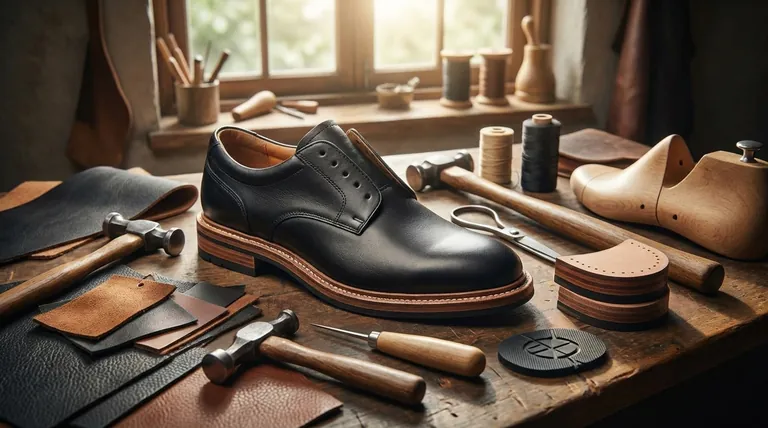At its core, a well-made leather shoe is an assembly of four primary components working in unison. These are the upper, which forms the body of the shoe; the lining, which dictates interior comfort; the sole, which is the point of contact with the ground; and the heel, which provides lift and stability. The quality of these parts, and how they are joined, is what separates an exceptional shoe from an ordinary one.
The true mark of a well-made shoe is not merely the presence of its components, but the quality of the materials used and, most critically, the method of its construction. Understanding this distinction is the key to identifying genuine value and durability.

The Anatomy of Quality: Deconstructing the Shoe
A shoe is more than the sum of its parts. The interaction between high-quality materials and skilled construction creates an object that is both durable and comfortable. Let's examine what to look for in each key component.
The Upper: The Face of the Shoe
The upper is the most visible part of the shoe, responsible for its structure and aesthetic. In a premium shoe, this is typically made from full-grain leather, which is the highest quality grade, retaining the natural grain and durability of the hide.
Lesser quality shoes might use "corrected-grain" or "bonded" leather, which are processed materials that lack the longevity and breathability of full-grain leather.
The Lining: The Unseen Mark of Comfort
The lining has a profound impact on how the shoe feels and wears over time. A full leather lining is the hallmark of a high-quality shoe.
Leather is naturally breathable and excellent at wicking moisture, which keeps your feet dry and comfortable. In contrast, many budget-friendly shoes use synthetic or fabric linings that can trap heat and moisture.
The Sole: The Foundation of Durability
The sole is the workhorse of the shoe, providing traction, protection, and support. The material and, more importantly, the construction method are critical indicators of quality.
High-end dress shoes often feature leather soles, which are traditional and breathable. For all-weather durability and grip, high-density rubber soles (like Dainite or Vibram) are a superior choice.
The Heel: Providing Stability and Lift
The heel provides balance and posture. A well-made shoe features a stacked leather heel, constructed from multiple layers of leather.
This construction is sturdy and can be easily repaired by a cobbler. A rubber top-lift is typically placed on the bottom layer to improve grip and absorb impact, extending the life of the heel.
Understanding the Trade-offs: Construction and Cost
The method used to attach the sole to the upper is arguably the single most important factor in a shoe's quality, longevity, and price.
Goodyear Welt vs. Cemented Construction
A Goodyear welt is a strip of leather stitched around the bottom edge of the upper, which is then stitched to the sole. This creates an incredibly durable, water-resistant, and—most importantly—resolable shoe. It is the gold standard for high-quality footwear.
Cemented construction, where the sole is simply glued to the upper, is far less expensive and results in a lighter, more flexible shoe out of the box. However, these shoes are rarely repairable and have a significantly shorter lifespan.
Leather vs. Rubber Soles
Choosing between a leather and rubber sole is a matter of purpose. Leather soles offer a classic, elegant profile and superior breathability, making them ideal for formal office environments.
Rubber soles provide far better traction and durability, especially in wet conditions, making them a more practical choice for daily commuting or variable weather.
How to Identify a Well-Made Shoe
Your choice depends on your specific needs for longevity, comfort, and environment. Use these points to guide your evaluation.
- If your primary focus is longevity and repairability: Seek out a shoe with a Goodyear welted construction and a full-grain leather upper, as this combination is built to be refurbished for decades.
- If your primary focus is immediate comfort and a lower price point: A shoe with a cemented construction can be a practical choice, but prioritize one with a quality leather upper and lining for better wear.
- If your primary focus is classic style and breathability for dry environments: A traditional leather sole paired with a full leather lining is the ideal combination for formal wear.
Ultimately, investing in a well-made shoe is an investment in durable materials and repairable construction.
Summary Table:
| Component | High-Quality Feature | Key Benefit |
|---|---|---|
| Upper | Full-Grain Leather | Superior durability & breathability |
| Lining | Full Leather Lining | Enhanced comfort & moisture-wicking |
| Sole | Goodyear Welt Construction | Long-lasting, waterproof, and resoleable |
| Heel | Stacked Leather | Sturdy, stable, and easily repairable |
Ready to source durable, high-quality leather footwear?
As a large-scale manufacturer, 3515 produces a comprehensive range of footwear for distributors, brand owners, and bulk clients. Our production capabilities encompass all types of shoes and boots, ensuring you receive products built with premium materials and superior construction methods.
Contact us today to discuss your manufacturing needs and discover how we can add value to your supply chain.
Visual Guide

Related Products
- Factory Direct Wholesale Leather Comfort Shoes with Dial Closure
- Wholesale Leather Business Casual Shoes with Dial Closure - Manufacturer of Comfort Dress Sneakers
- Wholesale Comfortable Business Casual Shoes Custom Manufacturing
- Wholesale Comfort Leather Business Shoes with Dial Lacing System
- Durable Rubber-Soled Utility Shoes for Wholesale & Custom Brand Manufacturing
People Also Ask
- How can one identify authentic leather footwear? A Guide to Spotting Genuine vs. Fake
- What are the advantages and disadvantages of using leather in shoes? Durability vs. Maintenance
- How should leather shoes be cleaned after each wear? A 60-Second Daily Ritual for Longevity
- How should business casual shoes be maintained? A Proactive System for Longevity & Style
- How does leather compare to other shoe materials in terms of durability and comfort? A Material Guide for Footwear



















